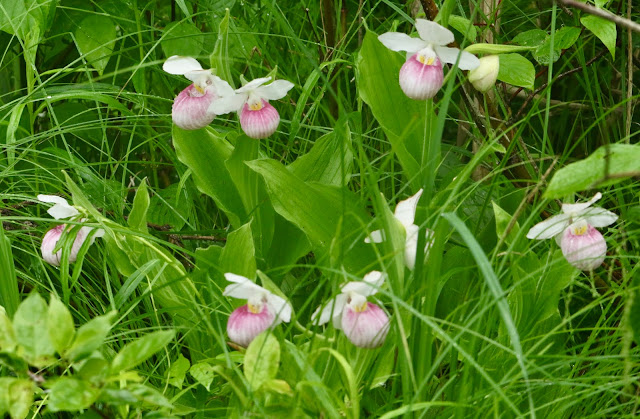Wild orchids are some of the most mysterious and alluring of wildflowers. Sadly, their beauty has lead many people to sneak around stealing them, a nasty practice that usually leads to the untimely demise of the orchids. Individual orchid species require very unique habitats, and wild orchids rarely survive transplanting. So guardians of land with wild orchids can be very secretive. Gott Fen, near Cleveland, is owned by the
Ohio Department of Natural Resources, and visiting requires special permission or participation in a ranger guided tour. I am on a quest to find wild orchids, so of course I considered it a must to sign up for a tour while the showy lady's slippers were blooming.
A fen is a wetland where the water has seeped through limestone, becoming alkaline. Showy lady's slippers are some of the rare plants that like it that way. Our guide explained that a survey in 2000 counted around 700 stems, but the most recent survey counted only 89. He said that Gott Fen is a carefully managed preserve, so the dramatic drop in the lady's slipper population despite their very best efforts is disheartening. Evidence points to the possibility that deer are grazing on them. (Another sign that a healthy ecosystem needs apex predators...sigh...) They did recently discover that the preserve is home to a small population of roundleaf sundew plants, which trap insects in their sticky dew and digest them for nutrients. Carnivorous plants are always an exciting thing to see! Gott Fen is also home to the spotted turtle, which is in severe decline. ODNR has taken some steps to help the turtle population. Their eggs are eaten by many different critters, such as raccoons and o'possums, so they have been trapping these animals and removing them when the turtles are laying their eggs. We caught a brief glimpse of the turtles frolicking in the water.
One of the coolest things that happened was when our guide jumped up and down, and from about 20 feet away we could feel the earth shake. He explained that dead plants do not easily decay in alkaline water, and they estimate there is a depth of 80 feet of spongy peat. Apparently the kind of bacteria that likes alkaline water is not very efficient at breaking down plant material.
If you'd like to be able to see the lady's slippers for yourself, check back next spring when they will be posting their guided walk during bloom time:
http://wildlife.ohiodnr.gov/calendar. The Cleveland Museum of Natural History also owns many preserves with rare plants including gorgeous orchids, and access is also through guided hikes that are listed here:
https://www.cmnh.org/adult-programs. In Pennsylvania, the Nature Conservancy owns the Tannersville Cranberry Bog with some amazing rare wildflowers (including orchids, and of course wild cranberries), and the Kettle Creek Environmental Center provides access through weekly guided walks:
https://www.mcconservation.org/tannersville-bog.html. This is much further away from Pittsburgh than the Ohio bogs.
 |
| Cow parsnip. |
 |
| False Solomon's seal. |
 |
| Baby eastern American toad. |
 |
| Roundleaf sundew. |
 |
| Common fleabane. |



















Comments
Post a Comment
Hello! I love to read your comments, but please be aware that they are moderated. This will result in a delay before they are posted. Thank you for your patience.